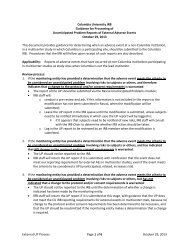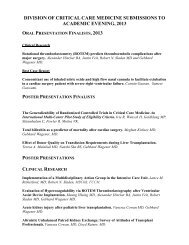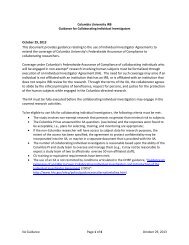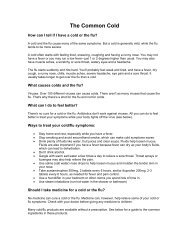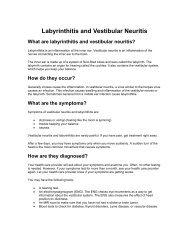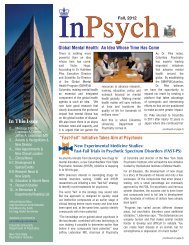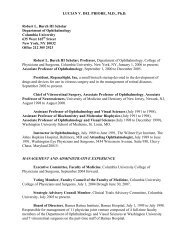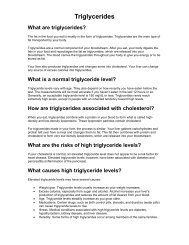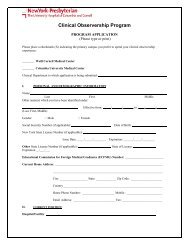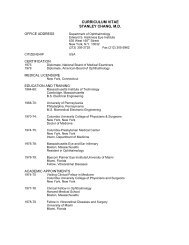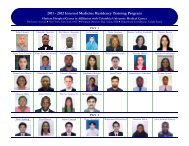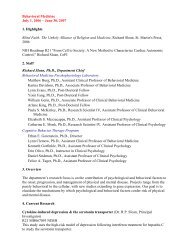news PS - Columbia University Medical Center
news PS - Columbia University Medical Center
news PS - Columbia University Medical Center
Create successful ePaper yourself
Turn your PDF publications into a flip-book with our unique Google optimized e-Paper software.
The Marks of Clinical and<br />
Research Excellence<br />
20 <strong>Columbia</strong>Medicine Spring 2012<br />
age-related muscle strength loss. “At this point we each know<br />
a lot about what is going on in each other’s laboratories,”<br />
Andrew says.<br />
Although the Marks family has made an impact in medicine,<br />
it started from humble beginnings. Paul was born in a Pennsylvania<br />
coal mining town and after his mother died when he was 5,<br />
he moved to his father’s parents’ modest apartment in Brooklyn.<br />
He went to <strong>Columbia</strong> <strong>University</strong> on a scholarship, graduating<br />
in 1946. In 1949, he graduated first in his class at P&S and did<br />
his residency in medicine at Presbyterian Hospital. Paul Marks<br />
says he learned about “creativity in science” and “performing at<br />
and identifying the highest standards in research” from his postdoctoral<br />
fellowship with Nobel Laureate Arthur Kornberg at the<br />
NIH from 1953 to 1955 and from a visiting scientist position<br />
with Nobelist Jacques Monod at the Pasteur Institute in 1961-62.<br />
“I was very lucky in my training,” Paul Marks recalls.<br />
“Monod was particularly demanding. If he thought you were<br />
good, the sky was the limit. Luckily, he thought I was good.<br />
Living with those standards every day you soon begin to see<br />
the scientists who were brilliant, those who were so-so, and<br />
those who were not so good.”<br />
Returning to <strong>Columbia</strong> in 1956, he studied globin genes<br />
and genetically determined anemias and thalassemias.<br />
By 1967, Marks became the founding chair of the new Department<br />
of Human Genetics and Development at P&S. He was<br />
appointed dean of the Faculty of Medicine in 1970, “a job I<br />
Andrew Marks credits his father’s steel<br />
backbone and passion about medicine and<br />
science for influencing his career choice.<br />
took with trepidation, since I always considered myself a scientist<br />
first.” In 1973, he became vice president of health sciences<br />
and director of the Cancer Research <strong>Center</strong>, which he helped<br />
found in 1972 as principal investigator on an application for<br />
National Cancer Institute funding. The center received comprehensive<br />
designation in 1979 and today — as the Herbert<br />
Irving Comprehensive Cancer <strong>Center</strong> — remains one of the<br />
elite NCI-designated cancer centers.<br />
“One of the major issues in leadership,” Paul Marks says,<br />
“is identifying talented faculty, and it was what I most liked to<br />
do as an administrator.” Two accomplishments he cites from<br />
his leadership at P&S are recruiting Eric Kandel, M.D., and<br />
persuading Richard Axel, M.D., to stay at <strong>Columbia</strong>. Both<br />
subsequently won Nobel Prizes.<br />
To have a major management role in cancer clinical care and<br />
research ultimately drew the senior Marks to Memorial Sloan-<br />
Kettering Cancer <strong>Center</strong> in 1980, where he became president<br />
and CEO of the newly merged institution. Of his achievements<br />
there – many of which challenged orthodoxy at the time – he<br />
is proudest of ushering MSKCC into the age of molecular biology<br />
and creating the first psychiatry department, pain service,<br />
free-standing breast cancer center, and adult day chemotherapy<br />
outpatient program at a cancer facility. MSKCC also was<br />
an early adopter of digital medical records.<br />
“One thing I learned as an administrator and researcher is<br />
that if anything new is proposed, someone will oppose it,” Paul<br />
Marks says. “If it’s really new, many, many people oppose it.”<br />
This was reflected in a 1987 New York Times magazine article<br />
examining Dr. Marks’ transformation of MSKCC.<br />
Although he retired as president emeritus in 1999, Paul Marks<br />
and his laboratory at MSKCC continue the SAHA research. He<br />
and colleagues first developed suberoylanilide hydroxamic acid,<br />
or SAHA, in 1987 as a small synthetic molecule that mimicked<br />
the action of the chemical solvent DMSO. In the 1970s, DMSO<br />
was shown to interact with globin genes in certain leukemic cells<br />
to stop their growth by turning them into red blood cells. The<br />
finding, at the time, revealed other ways to stop cells from being<br />
cancerous besides killing them. SAHA, by inhibiting the HDAC<br />
enzyme and other still unknown mechanisms, can make cancer<br />
cells non-malignant or can kill them.<br />
Andrew Marks credits his father’s steel backbone and passion<br />
about medicine and science for influencing his career<br />
choice. As did his mother Joan’s work: She established the<br />
genetic counseling program at Sarah Lawrence College. “I<br />
grew up with a love of science and familiarity with its lifestyle<br />
and culture,” Andrew Marks says. “There were always scientists<br />
around the house and at dinner.” But he says he had to<br />
work hard to get his busy professional parents’ respect. “After<br />
I got into the National Academy of Sciences [in 2005, a year<br />
after he was elected to the Institute of Medicine],” Andrew<br />
Marks says, “I joked with my parents, asking them whether<br />
I had finally earned the right to sit at the grown-ups table at<br />
Thanksgiving.” His daughter, Sarah, now hopes to join the<br />
family legacy; she plans to apply to medical school.<br />
It was not a foregone conclusion, though, that son Andrew<br />
would pursue medicine or research. He graduated from<br />
Amherst with a double major in biology and English and<br />
was the first student there to achieve honors in two subjects.<br />
He considered becoming a journalist and spent a summer at<br />
the Wall Street Journal as a reporter after winning a Dow<br />
Jones award for his college <strong>news</strong>paper journalism. He opted<br />
for medicine and research because journalism, he says, often<br />
involves uncovering others’ mistakes, while science is more<br />
positive as it prizes the discovery of new things. He obtained<br />
his medical degree from Harvard in 1980 and did his residency<br />
in medicine and fellowship in cardiology at the Massachusetts<br />
General Hospital then completed a postdoctoral fellowship in<br />
molecular biology there. After faculty appointments in cardiology<br />
at Harvard and Mount Sinai School of Medicine, he joined<br />
P&S in 1997 as director of the <strong>Center</strong> for Molecular Cardiology<br />
and the Clyde and Helen Wu Professor of Medicine and



